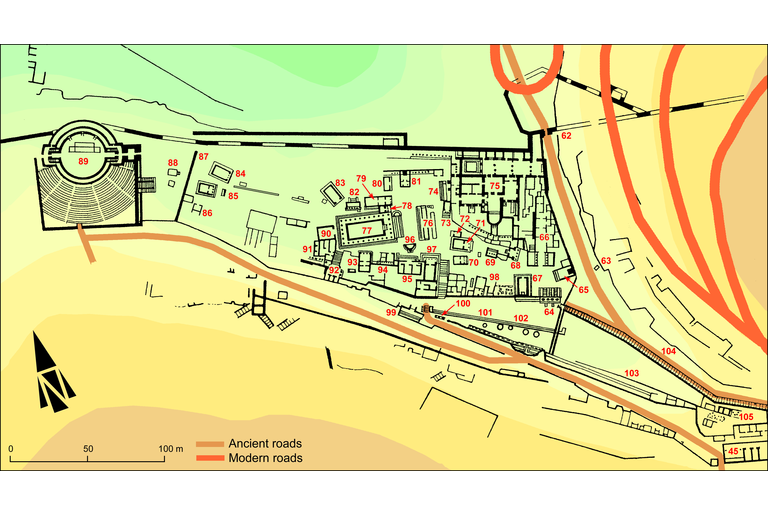Dedication to the Muses and the Nymphs
IGCyr096200
Trismegistos ID: 738472
Source Description
Repository
Cyrene Museum, 255.
Support
White marble rectangular base with a hole on top, broken off at back and at both lower angles (0.41; 0.10;0.20).
Layout
Inscribed on front face in three lines symmetrically displaid along vertical axis; however in the second half of l. 1 the letters are more pressed close to one another.
Letters
0.01; no serifs, alpha with dropped bar, smaller theta and omicron, xi with central vertical stroke, rho with small loop, non-slanting sigma, calice-shaped upsilon, very small loop of phi.
Place of Origin
Findspot.
Date
Probably second century B.C. (lettering)
Findspot
Found by G. Oliverio in 1925 at Cyrene pleiades; HGL : in the Sanctuary of Apollo .
Later recorded Location
Seen by Pugliese Carratelli in 1960 in Shahat : Cyrene Museum .
Last recorded Location
Seen by C. Dobias-Lalou in 1976 at the same place.
Text constituted from
Transcription from stone (CDL).
Bibliography
Oliverio, 1927 Oliverio, G., 1927, Campagna di scavi a Cirene nell'estate del 1925: II. Documenti epigrafici del santuario di Apollo, Africa Italiana1, 156-158 - see in bibliography , p. 157 (mention of find); Oliverio, Taccuini inediti Oliverio, G., Taccuini inediti - see in bibliography , XI.70, whence SECir Oliverio, G., Pugliese-Carratelli, G., Morelli, D., 1961-1962, Supplemento Epigrafico Cirenaico, Annuario della Scuola Archeologica di Atene e delle Missioni Italiane in Oriente (ASAA)39-40 (= n.s. 23-24), 219-375 - see in bibliography , 52; Robert, Bulletin Épigraphique Robert, J. and L., Bulletin Épigraphique in Revue des Études Grecques (REG)1938-1984 - see in bibliography , 1964.562.
Apparatus
2 SECir Oliverio, G., Pugliese-Carratelli, G., Morelli, D., 1961-1962, Supplemento Epigrafico Cirenaico, Annuario della Scuola Archeologica di Atene e delle Missioni Italiane in Oriente (ASAA)39-40 (= n.s. 23-24), 219-375 - see in bibliography Βασώ : Robert, Bulletin Épigraphique Robert, J. and L., Bulletin Épigraphique in Revue des Études Grecques (REG)1938-1984 - see in bibliography Βασῶ (from the Roberts' commentary)
French translation
Aiskhinès fils de Sôsarkhos, Kallikleia fille de Xouthos et Basô fille d'Aiskhinès ont consacré (ce monument) aux Muses et aux Nymphes.
English translation
Aischines son of Sosarchos, Kallikleia daughter of Xouthos and Baso daughter of Aischines dedicated (this monument) to the Muses and to the Nymphs.
Italian translation
Aischines figlio di Sosarchos, Kallikleia figlia di Xouthos e Basò figlia di Aischines hanno dedicato (questo monumento) alle Muse e alle Ninfe.
Commentary
The father's names show that Baso was the daughter of Aischines and Kallikleia would have been their daughter.
Two readings are possible for a name written ΒΑΣΩ, either a nominative Βασώ or an accusative Βασῶ. Pugliese Carratelli printed the nominative reading, which was clearly Oliverio's option, as he had already mentioned the find at Oliverio, 1927 Oliverio, G., 1927, Campagna di scavi a Cirene nell'estate del 1925: II. Documenti epigrafici del santuario di Apollo, Africa Italiana1, 156-158 - see in bibliography , p. 157 as a dedication made by 'the family of Aischines son of Sositratos'. This position was endorsed by C. Dobias-Lalou at Dobias-Lalou, 2000 Dobias-Lalou, C., 2000, Le dialecte des inscriptions grecques de Cyrène, Karthago25, Paris - see in bibliography , p.98. Conversely, J. and L. Robert had opted for an accusative, thus a dedication of the statue of the girl by her parents. In fact Muses and Nymphs would be the right patronesses for a young girl. However a circular hole on top of this small and low base would not support a statue. The nominative seems eventually better, but the question should perhaps remain open.
Creative Commons Attributions-NonCommercial 4.0 International License.
All citation, reuse or distribution of this work must contain a link back to DOI: http://doi.org/10.6092/UNIBO/IGCYRGVCYR and the filename (IGCyr000000 or GVCyr000), as well as the year of consultation.
